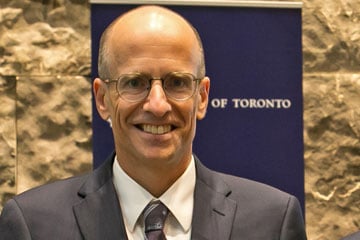
The University of Toronto Faculty of Law announced Thursday it has raised $24 million, including $15 million for financial aid from alumni and other supporters, in the school’s campaign to provide greater financial aid to law students.

The University of Toronto Faculty of Law announced Thursday it has raised $24 million, including $15 million for financial aid from alumni and other supporters, in the school’s campaign to provide greater financial aid to law students.
“I think all law schools have to be increasingly conscious of the need to devote operating budget as well as philanthropy to support [financial aid], but it's a constant challenge,” says Edward Iacobucci, dean of the Faculty of Law at U of T.
At $36,720 per year, U of T Law has the highest law school tuition in the country.
To determine who receives aid, the university measures tuition, living expenses and the budgets of students and distributes the bursaries to fill the gaps between what the students have and what they need. About 50 per cent of the students at U of T have “unmet needs” and qualify for financial aid, says Iacobucci. Last year, 36 per of that unmet need was covered with bursaries.
“I don’t think it’s about tuition; I think it’s about accessibility,” says Mark Wiseman, campaign co-chairman and global head of active equities for investment management company BlackRock.
Wiseman, who graduated in 1996 from the LLB/MBA program, says he received financial assistance while attending U of T.
“Regardless of what tuition is, whether it is at the lower cost when I was a student or at the higher cost today, there are always people that need assistance to have access,” he says. “And if this is going to continue to be a world class institution and a critically important institution for Canada, then we have to ensure that the best and brightest are able to come here regardless of means.”
Featured at the event as a beneficiary of the university’s financial aid was Kia Dunn, a third-year law student, who is originally from Ottawa. Dunn says the school’s high tuition is balanced by the level of support available to those who need it.
“If this model works, where you have a high upfront cost, it’s almost distributive, says Dunn. “If they redirect that to bursaries, to these kinds of initiatives and produce enough money to actually equalize that, then it could work as a model.”
U of T also offers to pay interest until the year after articling on a $150,000 line of credit. But while those who need it can count on substantial support, those coming from middle-income levels find it harder to justify spending $36,000 a year.
“There’s definitely those people who fall through the cracks, because they come from those middle- income areas, and they don’t get enough support and maybe they choose to go elsewhere for that reason,” he says.
“There’s definitely a push to pull up the bottom first, like people who have very distinct stories. It might make more sense for them to start with those people and make sure they can attend, but then I hope they keep moving it to the middle,” he says.
Dunn says that while tuition at U of T is high, he sees the school as providing the best opportunity to get a job in a large Toronto firm.
“They charge a lot, but they also enable you to pay it and I think work pretty hard to put you in a position to pay it off.”
Law school has “basically become unaffordable, unless you're from the privileged class or somehow managed to get a huge scholarship,” says Paula McGirr, a senior lawyer with the family law service centre of Legal Aid Ontario and an adjunct professor at Osgoode Hall Law School. She says the tuition at U of T and Osgoode is “outrageous.”
The cost of law school is troubling for two reasons, McGirr says. Students are leaving school with enormous debt and many graduate without being able to get an articling position.
“I think they’re letting way too many students in. I think the prices are outrageous,” she says. “You shouldn’t be walking out of law school in debt to the tune of $100,000, not being able to get an articling position or a job as a lawyer after you article.”
Only 10 per cent of Ontario firms offer articling positions, while the number of graduates from Ontario law programs rose by 60 per cent from 2007 to 2012, and every September, between 200 and 300 candidates do not find an articling position in time for articling season, according to the Law Society of Ontario’s Professional Development and Competence Committee’s Lawyer Licensing Consultation paper.
Iacobucci says that decades ago, before tuition was regulated, U of T was the first law school to begin raising its tuition, knowing government support would dramatically wane. Then the government stepped in and put a cap on that increase. Law schools can only add five per cent to their tuition per year, and Iacobucci says U of T’s number-one spot for tuition costs can be attributed to his counterparts’ inability to catch up in their yearly increases.
“This is a first-class legal education and putting on a first-class legal education,” he says. “You know, we have professors with as few as 15 students in the class. . . . A big class for us is 75 students. That makes for an excellent legal education, but it’s not cheap to put on.”